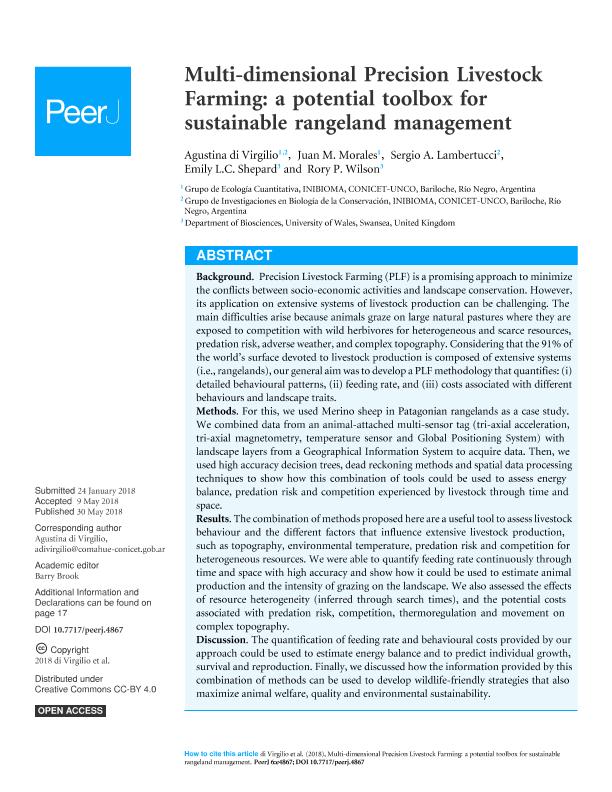Mostrar el registro sencillo del ítem
dc.contributor.author
Di Virgilio, Agustina Soledad

dc.contributor.author
Morales, Juan Manuel

dc.contributor.author
Lambertucci, Sergio Agustin

dc.contributor.author
Shepard, Emily L.C.
dc.contributor.author
Wilson, Rory P.
dc.date.available
2019-12-02T17:22:53Z
dc.date.issued
2018-05-30
dc.identifier.citation
Di Virgilio, Agustina Soledad; Morales, Juan Manuel; Lambertucci, Sergio Agustin; Shepard, Emily L.C.; Wilson, Rory P.; Multi-dimensional Precision Livestock Farming: A potential toolbox for sustainable rangeland management; PeerJ; PeerJ; 2018; 5; 30-5-2018; 1-23
dc.identifier.issn
2167-8359
dc.identifier.uri
http://hdl.handle.net/11336/91088
dc.description.abstract
Background. Precision Livestock Farming (PLF) is a promising approach to minimize the conflicts between socio-economic activities and landscape conservation. However, its application on extensive systems of livestock production can be challenging. The main difficulties arise because animals graze on large natural pastures where they are exposed to competition with wild herbivores for heterogeneous and scarce resources, predation risk, adverse weather, and complex topography. Considering that the 91% of the world's surface devoted to livestock production is composed of extensive systems (i.e., rangelands), our general aim was to develop a PLF methodology that quantifies: (i) detailed behavioural patterns, (ii) feeding rate, and (iii) costs associated with different behaviours and landscape traits. Methods. For this, we used Merino sheep in Patagonian rangelands as a case study. We combined data from an animal-attached multi-sensor tag (tri-axial acceleration, tri-axial magnetometry, temperature sensor and Global Positioning System) with landscape layers from a Geographical Information System to acquire data. Then, we used high accuracy decision trees, dead reckoning methods and spatial data processing techniques to show how this combination of tools could be used to assess energy balance, predation risk and competition experienced by livestock through time and space. Results. The combination of methods proposed here are a useful tool to assess livestock behaviour and the different factors that influence extensive livestock production, such as topography, environmental temperature, predation risk and competition for heterogeneous resources. We were able to quantify feeding rate continuously through time and space with high accuracy and show how it could be used to estimate animal production and the intensity of grazing on the landscape. We also assessed the effects of resource heterogeneity (inferred through search times), and the potential costs associated with predation risk, competition, thermoregulation and movement on complex topography. Discussion. The quantification of feeding rate and behavioural costs provided by our approach could be used to estimate energy balance and to predict individual growth, survival and reproduction. Finally, we discussed how the information provided by this combination of methods can be used to develop wildlife-friendly strategies that also maximize animal welfare, quality and environmental sustainability.
dc.format
application/pdf
dc.language.iso
eng
dc.publisher
PeerJ
dc.rights
info:eu-repo/semantics/openAccess
dc.rights.uri
https://creativecommons.org/licenses/by/2.5/ar/
dc.subject
HUMAN-WILDLIFE CONFLICTS
dc.subject
PRECISION LIVESTOCK FARMING
dc.subject
RANGELAND CONSERVATION
dc.subject
SPATIAL-MULTI-SENSOR APPROACH
dc.subject
SUSTAINABLE LIVESTOCK MANAGEMENT
dc.subject.classification
Ecología

dc.subject.classification
Ciencias Biológicas

dc.subject.classification
CIENCIAS NATURALES Y EXACTAS

dc.title
Multi-dimensional Precision Livestock Farming: A potential toolbox for sustainable rangeland management
dc.type
info:eu-repo/semantics/article
dc.type
info:ar-repo/semantics/artículo
dc.type
info:eu-repo/semantics/publishedVersion
dc.date.updated
2019-10-10T13:54:19Z
dc.journal.volume
2018
dc.journal.number
5
dc.journal.pagination
1-23
dc.journal.pais
Estados Unidos

dc.journal.ciudad
Nueva York
dc.description.fil
Fil: Di Virgilio, Agustina Soledad. Consejo Nacional de Investigaciones Científicas y Técnicas. Centro Científico Tecnológico Conicet - Patagonia Norte. Instituto de Investigaciones en Biodiversidad y Medioambiente. Universidad Nacional del Comahue. Centro Regional Universidad Bariloche. Instituto de Investigaciones en Biodiversidad y Medioambiente; Argentina
dc.description.fil
Fil: Morales, Juan Manuel. Consejo Nacional de Investigaciones Científicas y Técnicas. Centro Científico Tecnológico Conicet - Patagonia Norte. Instituto de Investigaciones en Biodiversidad y Medioambiente. Universidad Nacional del Comahue. Centro Regional Universidad Bariloche. Instituto de Investigaciones en Biodiversidad y Medioambiente; Argentina
dc.description.fil
Fil: Lambertucci, Sergio Agustin. Consejo Nacional de Investigaciones Científicas y Técnicas. Centro Científico Tecnológico Conicet - Patagonia Norte. Instituto de Investigaciones en Biodiversidad y Medioambiente. Universidad Nacional del Comahue. Centro Regional Universidad Bariloche. Instituto de Investigaciones en Biodiversidad y Medioambiente; Argentina
dc.description.fil
Fil: Shepard, Emily L.C.. Swansea University; Reino Unido
dc.description.fil
Fil: Wilson, Rory P.. Swansea University; Reino Unido
dc.journal.title
PeerJ
dc.relation.alternativeid
info:eu-repo/semantics/altIdentifier/url/https://peerj.com/articles/4867/
dc.relation.alternativeid
info:eu-repo/semantics/altIdentifier/doi/https://doi.org/10.7717/peerj.4867
Archivos asociados
